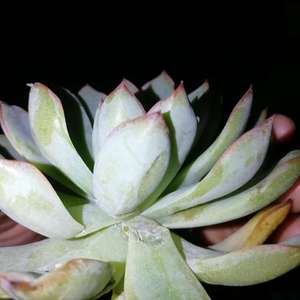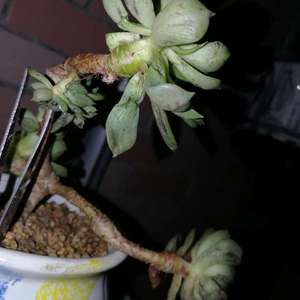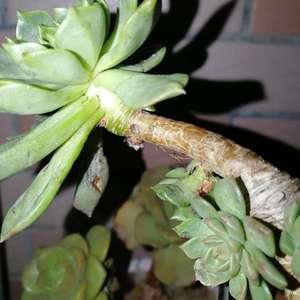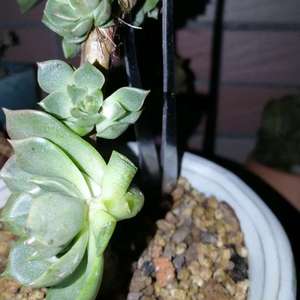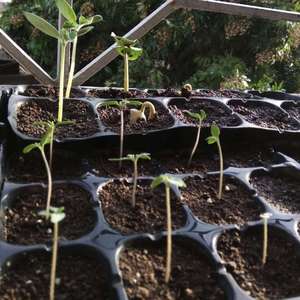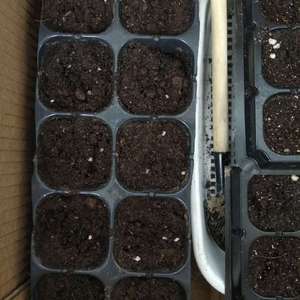求助
jordi
2018年07月26日

ID Help Please !! I have this plant and have had it for 2-3 years. The third pic is the plant as a baby. This big boy got so tall and is now over 1 and a half feet (not even straightened, I measured it while it was in its natural position) It was about 6 inches when I first got it. Some sticks are in the soil to help hold the limbs up, they are not part of the plant. Thanks !

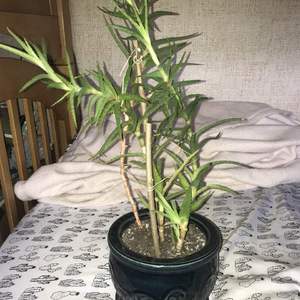
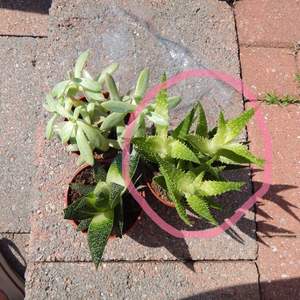
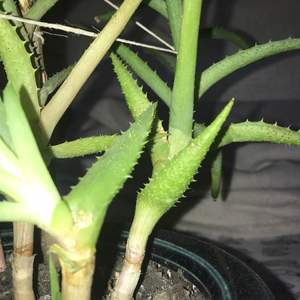




0
0
初心~:你这个长成了恨天高
jordi:@Shanee I think it wouldn’t be a candelabra since I’ve had it for a long time and it hasn’t flowered. It is gooey inside so it’s possible though. Thanks so much !
Shanee:Possible candelabra aloe. Or aloe Vera that’s needing more light.
文章
Miss Chen
2018年07月26日

Description: This plant is a summer annual about 3-9' tall. It is unbranched or little branched. The stout central stem is light green; where new growth occurs, this stem is more or less pubescent, but it becomes less hairy with age. The lower leaves are often opposite, while the upper leaves are alternate. These leaves are palmately compound with 3-9 leaflets (usually there are 5-7 leaflets). On large plants, these leaves can span up to 10" long and across (excluding the petioles), but they are half this size on smaller plants. While the lower leaves have long slender petioles, the upper leaves are nearly sessile. These petioles are more or less pubescent and occasionally reddish green. Each leaflet is narrowly ovate and coarsely serrated along the margins; the middle leaflets are larger in size than the lateral leaflets. The upper surface of each leaflet is dark green and sparsely pubescent.
Hemp is dioecious with both male and female plants. The male plants produce both axillary and terminal panicles of male flowers. These panicles are up to 1' long; they have small leafy bracts and pubescent stalks. Each male flower is about 1/8" (3 mm.) across, consisting of 5 sepals, 5 stamens with large anthers, and no petals. The oblong or lanceolate sepals are initially green, but they become cream or pale yellow with maturity. After these flowers have shed their pollen, the foliage of the male plant soon turns yellow and withers away. The female plants produce short axillary spikes of female flowers; these spikes are about 1" long and covered with glandular hairs. Each female flower is about 1/8" (3 mm.) long, consisting of a single sepal, an ovary with two styles, and no petals. The sepal wraps around the ovary, forming a beak at its apex; the 2 styles are exerted from this beak. The surface of the sepal is green and covered with glandular hairs that exude a characteristic odor when they are rubbed. At the base of each female flower, there is a single green bract that is lanceolate and longer than the flower. There are small leaves and other bracts along the spike as well.

The blooming period occurs from mid-summer to early fall and lasts about 1-2 months. Pollination is by agency of the wind. Upon maturity, the female flowers turn brown, but the foliage of female plants remains green until the fall. Each female flower is replaced by an achene containing a single large seed. The root system consists of a branched taproot. This plant often forms colonies at favorable sites.
Cultivation: The preference is full sun, moist conditions, and a fertile loamy soil. Mesic conditions and other kinds of soil are also tolerated, but the size of plants will be smaller. Hemp is little bothered by pests and disease. It tolerates occasional flooding.

Range & Habitat: Hemp occurs occasionally in central and northern Illinois, while in the southern portion of the state it is uncommon or absent (see Distribution Map). Hemp is native to central Asia and it was introduced to the United States for agricultural purposes. Habitats include borders of floodplain woodlands, borders of low-lying fields, weedy meadows along rivers, fence rows, and roadside ditches. Occasionally, it is cultivated illegally in backyards and fields. This plant is found primarily in disturbed habitats.
Faunal Associations: There is little information about floral-faunal relationships for Hemp. The wind-pollinated flowers don't attract many insect pollinators. Mammalian herbivores avoid browsing on hemp when other plants are available.
Photographic Location: A roadside ditch in Champaign, Illinois.

Comments: Hemp has been cultivated in the United States since colonial times. The fibers of the central stem are quite strong; they have been used in making rope, paper, clothing, and other products. The foliage, flowers, and seeds of female plants contain chemicals with medicinal and recreational properties. However, since World War II, it has been illegal in Illinois and other areas of the United States to cultivate hemp. The industrial form of this plant is Cannabis sativa sativa (Hemp), while the medicinal and recreational form is Cannabis sativa indica (Marijuana). It is usually the industrial form of this plant that is encountered in the wild; it has a more robust habit of growth and contains lower levels of chemicals with medicinal and recreational properties. Hemp has a unique appearance and is easy to distinguish from other species of plants. A small specimen of Hemp superficially resembles some Potentilla spp. (Cinquefoils), especially Potentilla recta (Sulfur Cinquefoil), because of the similarity of their palmate leaves. However, the leaflets of Hemp are more elongated and tapered at their tips than Sulfur Cinquefoil. Furthermore, the flowers of Cinquefoils have 5 conspicuous petals that are white or yellow, like many other members of the Rose family, while the flowers of Hemp are devoid of petals.
Hemp is dioecious with both male and female plants. The male plants produce both axillary and terminal panicles of male flowers. These panicles are up to 1' long; they have small leafy bracts and pubescent stalks. Each male flower is about 1/8" (3 mm.) across, consisting of 5 sepals, 5 stamens with large anthers, and no petals. The oblong or lanceolate sepals are initially green, but they become cream or pale yellow with maturity. After these flowers have shed their pollen, the foliage of the male plant soon turns yellow and withers away. The female plants produce short axillary spikes of female flowers; these spikes are about 1" long and covered with glandular hairs. Each female flower is about 1/8" (3 mm.) long, consisting of a single sepal, an ovary with two styles, and no petals. The sepal wraps around the ovary, forming a beak at its apex; the 2 styles are exerted from this beak. The surface of the sepal is green and covered with glandular hairs that exude a characteristic odor when they are rubbed. At the base of each female flower, there is a single green bract that is lanceolate and longer than the flower. There are small leaves and other bracts along the spike as well.

The blooming period occurs from mid-summer to early fall and lasts about 1-2 months. Pollination is by agency of the wind. Upon maturity, the female flowers turn brown, but the foliage of female plants remains green until the fall. Each female flower is replaced by an achene containing a single large seed. The root system consists of a branched taproot. This plant often forms colonies at favorable sites.
Cultivation: The preference is full sun, moist conditions, and a fertile loamy soil. Mesic conditions and other kinds of soil are also tolerated, but the size of plants will be smaller. Hemp is little bothered by pests and disease. It tolerates occasional flooding.

Range & Habitat: Hemp occurs occasionally in central and northern Illinois, while in the southern portion of the state it is uncommon or absent (see Distribution Map). Hemp is native to central Asia and it was introduced to the United States for agricultural purposes. Habitats include borders of floodplain woodlands, borders of low-lying fields, weedy meadows along rivers, fence rows, and roadside ditches. Occasionally, it is cultivated illegally in backyards and fields. This plant is found primarily in disturbed habitats.
Faunal Associations: There is little information about floral-faunal relationships for Hemp. The wind-pollinated flowers don't attract many insect pollinators. Mammalian herbivores avoid browsing on hemp when other plants are available.
Photographic Location: A roadside ditch in Champaign, Illinois.

Comments: Hemp has been cultivated in the United States since colonial times. The fibers of the central stem are quite strong; they have been used in making rope, paper, clothing, and other products. The foliage, flowers, and seeds of female plants contain chemicals with medicinal and recreational properties. However, since World War II, it has been illegal in Illinois and other areas of the United States to cultivate hemp. The industrial form of this plant is Cannabis sativa sativa (Hemp), while the medicinal and recreational form is Cannabis sativa indica (Marijuana). It is usually the industrial form of this plant that is encountered in the wild; it has a more robust habit of growth and contains lower levels of chemicals with medicinal and recreational properties. Hemp has a unique appearance and is easy to distinguish from other species of plants. A small specimen of Hemp superficially resembles some Potentilla spp. (Cinquefoils), especially Potentilla recta (Sulfur Cinquefoil), because of the similarity of their palmate leaves. However, the leaflets of Hemp are more elongated and tapered at their tips than Sulfur Cinquefoil. Furthermore, the flowers of Cinquefoils have 5 conspicuous petals that are white or yellow, like many other members of the Rose family, while the flowers of Hemp are devoid of petals.
0
0
文章
Miss Chen
2018年07月26日

Description: This herbaceous perennial plant is 1½–3' tall and little branched. The central stem is light green to reddish brown, glabrous to slightly hairy, and terete or angular. The alternate leaves are up to 5" long, 2" across, and variable in shape; the lowest leaves are often cordate-oval, while the middle and upper leaves are ovate-lanceolate to lanceolate. All of these leaves have crenate or serrated margins; their upper surfaces are medium to dark green, while their lower surfaces are light green and short-hairy along the veins. The lower and middle leaves have slender petioles, while the upper leaves are more likely to be sessile. Sometimes short leafy stalks develop from the axils of the leaves on the central stem.
The central stem terminates in an elongated raceme of flowers up to 1' long. The flowers tend to nod downward along one side of the raceme on short pedicels. At the base of each pedicel, there is a small leafy bract that is linear-lanceolate in shape. Sometimes nodding flowers are produced from the axils of the upper leaves on longer pedicels. Each flower has a bell-shaped blue-violet corolla, 5 green sepals, 5 stamens, and an exerted style with 3 curled stigmas. The corolla is 1–1½" long and half as much across; it has 5 pointed lobes that are recurved. The sepals are linear-lanceolate in shape, widely spreading to recurved, and much smaller in size than the corolla. The style is white or pale purple. The blooming period occurs from mid-summer to early fall and lasts about a month. Each flower is replaced by a globoid seed capsule that contains several small seeds. The root system is rhizomatous. Occasionally, small colonies of plants are produced from the long rhizomes.
Cultivation: The preference is full to partial sun, more or less mesic conditions, and a fertile loamy soil.

Range & Habitat: Creeping Bellflower naturalizes occasionally in northern Illinois and uncommonly in central Illinois; it is apparently rare or absent in southern Illinois (see Distribution Map). This species was introduced into North America from Europe as an ornamental plant. Habitats include open woodlands, savannas, thickets, fence rows, edges of yards, roadsides, and waste areas. Creeping Bellflower is often cultivated in gardens because of its showy flowers.
Faunal Associations: According to Müller (1873/1883), the flowers of Creeping Bellflower produce both nectar and pollen. Müller observed honeybees, bumblebees, Halictid bees, and other bees visiting the flowers for nectar or pollen in Germany; he also observed a Syrphid fly with a long proboscis (Rhingia sp.) sucking nectar from the flowers. Aside from these observations, further information about floral-faunal relationships for this species are unavailable.

Photographic Location: The photographs were taken at a flower garden in Urbana, Illinois.
Comments: Creeping Bellflower has very showy flowers. Among the Eurasian bellflowers that are cultivated, this is the species that most often escapes — in part because it is more commonly cultivated. A species that has naturalized less often in Illinois, Campanula glomerata (Clustered Bellflower), has more erect flowers that are clustered together at the apex each central stem. The flowers of this species have sepals that are longer and wider than those of Creeping Bellflower. The circumboreal Campanula rotundifolia (Harebells) and native Campanulastrum americanum (American Bellflower) are quite distinct from Creeping Bellflower. Harebells has linear leaves along its stems and its bell-shaped flowers are smaller in size (usually less than 1" in length) than those of creeping Bellflower. The flowers of American Bellflower have shallow corollas that are star-shaped with widely spreading lobes; the older scientific name of this latter species is Campanula americana.
The central stem terminates in an elongated raceme of flowers up to 1' long. The flowers tend to nod downward along one side of the raceme on short pedicels. At the base of each pedicel, there is a small leafy bract that is linear-lanceolate in shape. Sometimes nodding flowers are produced from the axils of the upper leaves on longer pedicels. Each flower has a bell-shaped blue-violet corolla, 5 green sepals, 5 stamens, and an exerted style with 3 curled stigmas. The corolla is 1–1½" long and half as much across; it has 5 pointed lobes that are recurved. The sepals are linear-lanceolate in shape, widely spreading to recurved, and much smaller in size than the corolla. The style is white or pale purple. The blooming period occurs from mid-summer to early fall and lasts about a month. Each flower is replaced by a globoid seed capsule that contains several small seeds. The root system is rhizomatous. Occasionally, small colonies of plants are produced from the long rhizomes.
Cultivation: The preference is full to partial sun, more or less mesic conditions, and a fertile loamy soil.

Range & Habitat: Creeping Bellflower naturalizes occasionally in northern Illinois and uncommonly in central Illinois; it is apparently rare or absent in southern Illinois (see Distribution Map). This species was introduced into North America from Europe as an ornamental plant. Habitats include open woodlands, savannas, thickets, fence rows, edges of yards, roadsides, and waste areas. Creeping Bellflower is often cultivated in gardens because of its showy flowers.
Faunal Associations: According to Müller (1873/1883), the flowers of Creeping Bellflower produce both nectar and pollen. Müller observed honeybees, bumblebees, Halictid bees, and other bees visiting the flowers for nectar or pollen in Germany; he also observed a Syrphid fly with a long proboscis (Rhingia sp.) sucking nectar from the flowers. Aside from these observations, further information about floral-faunal relationships for this species are unavailable.

Photographic Location: The photographs were taken at a flower garden in Urbana, Illinois.
Comments: Creeping Bellflower has very showy flowers. Among the Eurasian bellflowers that are cultivated, this is the species that most often escapes — in part because it is more commonly cultivated. A species that has naturalized less often in Illinois, Campanula glomerata (Clustered Bellflower), has more erect flowers that are clustered together at the apex each central stem. The flowers of this species have sepals that are longer and wider than those of Creeping Bellflower. The circumboreal Campanula rotundifolia (Harebells) and native Campanulastrum americanum (American Bellflower) are quite distinct from Creeping Bellflower. Harebells has linear leaves along its stems and its bell-shaped flowers are smaller in size (usually less than 1" in length) than those of creeping Bellflower. The flowers of American Bellflower have shallow corollas that are star-shaped with widely spreading lobes; the older scientific name of this latter species is Campanula americana.
0
0
文章
Miss Chen
2018年07月26日

Description: This plant is an annual or biennial about 1-3' tall. Small plants are branched sparingly, while large plants branch abundantly in the upper half. The stems are gray-green or gray-blue, terete, glabrous, and glaucous. Plants that begin growth during the fall will overwinter as low rosettes with basal leaves, while plants that begin growth during the spring bolt upward almost immediately. Both the basal and lower leaves are up to 10" long and 2" across, but they are usually smaller than this. They are oblanceolate in overall shape and strongly pinnatifid with undulate or bluntly dentate margins; their terminal lobes are the largest in size. Both types of leaves have stout petioles. In contrast, the middle to upper leaves are smaller in size, lanceolate-oblong in shape, with margins that are smooth or bluntly dentate. These latter leaves have bases that usually clasp their stems, although some of them may be sessile. Like the stems, these various leaves are grey-green or blue-green, glaucous, and usually glabrous – occasionally the basal leaves have short bristly hairs. The lower, middle, and upper leaves are alternate.
The upper stems terminate in racemes of bright yellow flowers. The flowers bloom toward the apex of each raceme, while the seedpods develop below. Each flower is 1/3–1/2" (8-12 mm.) across, consisting of 4 yellow petals, 4 green to yellow sepals, several stamens, and a pistil with a single style. The sepals are narrowly lanceolate and hairless. The blooming period can occur anytime between late spring to early fall; it usually lasts about 1 month for a small colony of plants. Each flower is replaced by an ascending cylindrical seedpod (silique) that is 1¼–2¼" long at maturity and hairless. Each seedpod terminates in a seedless beak that is about one-fourth its entire length. At the base of each seedpod, there is a stout hairless pedicel about ½" long that is widely spreading to ascending. Each seedpod divides into 2 valves to release its small globoid seeds. The root system consists of a taproot. This plant reproduces by reseeding itself.
Cultivation: Rape Mustard prefers full sunlight, moist to dry conditions, and a neutral to alkaline soil containing loam, clay-loam, or gravelly material. The size of individual plants varies greatly according to moisture conditions and soil fertility.
Range & Habitat: Rape Mustard is occasional in most areas of Illinois (see Distribution Map). It is native to Eurasia. Typical habitats include cropland, weedy fields, roadsides, gravelly areas along railroads, and waste areas. This plant is usually found in areas with a history of disturbance where there is scant ground vegetation.

Faunal Associations: The nectar of the flowers attracts small bees and White butterflies (Pieridae); some bees may collect pollen from the flowers as well. The caterpillars of the butterflies Pieris napi (Mustard White), Pieris rapae (Cabbage White), and Pontia protodice (Checkered White) feed on Brassica spp. (Mustards), as do the caterpillars of the moths Evergestis pallidata (Purple-Backed Cabbageworm) and Plutella xylostella (Diamondback Moth). Several species of flea beetles (primarily Phyllotreta spp.), Murgantia histrionica (Harlequin Bug), and Adelphocoris superbus (Meadow Plant Bug) also feed on the foliage of these plants. The oily seeds of Rape Mustard and similar species are eaten by the Mourning Dove and Ring-Necked Pheasant, and the mild-tasting foliage can be eaten in limited amounts by livestock and other mammalian herbivores.
Photographic Location: A gravelly area along a railroad in Savoy, Illinois.
Comments: This is another weedy mustard species from Eurasia. It should not be confused with the agricultural crop, Oilseed Rape (or Canola), which is Brassica napus oleifera, or one of the cultivated vegetables. Rape Mustard has several common names, including Field Mustard and Birdseed Rape. In general, Rape Mustard can be distinguished from other Brassica spp. (Mustards) by its glaucous gray-blue or gray-green foliage and its clasping alternate leaves. A similar species, Brassica oleracea (Wild Cabbage), shares these characteristics, but this latter species has larger flowers (exceeding ½" across) and it is quite rare in Illinois. Oilseed Rape has foliage that is more green than either Rape Mustard or Wild Cabbage, and its foliage isn't glaucous.
The upper stems terminate in racemes of bright yellow flowers. The flowers bloom toward the apex of each raceme, while the seedpods develop below. Each flower is 1/3–1/2" (8-12 mm.) across, consisting of 4 yellow petals, 4 green to yellow sepals, several stamens, and a pistil with a single style. The sepals are narrowly lanceolate and hairless. The blooming period can occur anytime between late spring to early fall; it usually lasts about 1 month for a small colony of plants. Each flower is replaced by an ascending cylindrical seedpod (silique) that is 1¼–2¼" long at maturity and hairless. Each seedpod terminates in a seedless beak that is about one-fourth its entire length. At the base of each seedpod, there is a stout hairless pedicel about ½" long that is widely spreading to ascending. Each seedpod divides into 2 valves to release its small globoid seeds. The root system consists of a taproot. This plant reproduces by reseeding itself.
Cultivation: Rape Mustard prefers full sunlight, moist to dry conditions, and a neutral to alkaline soil containing loam, clay-loam, or gravelly material. The size of individual plants varies greatly according to moisture conditions and soil fertility.
Range & Habitat: Rape Mustard is occasional in most areas of Illinois (see Distribution Map). It is native to Eurasia. Typical habitats include cropland, weedy fields, roadsides, gravelly areas along railroads, and waste areas. This plant is usually found in areas with a history of disturbance where there is scant ground vegetation.

Faunal Associations: The nectar of the flowers attracts small bees and White butterflies (Pieridae); some bees may collect pollen from the flowers as well. The caterpillars of the butterflies Pieris napi (Mustard White), Pieris rapae (Cabbage White), and Pontia protodice (Checkered White) feed on Brassica spp. (Mustards), as do the caterpillars of the moths Evergestis pallidata (Purple-Backed Cabbageworm) and Plutella xylostella (Diamondback Moth). Several species of flea beetles (primarily Phyllotreta spp.), Murgantia histrionica (Harlequin Bug), and Adelphocoris superbus (Meadow Plant Bug) also feed on the foliage of these plants. The oily seeds of Rape Mustard and similar species are eaten by the Mourning Dove and Ring-Necked Pheasant, and the mild-tasting foliage can be eaten in limited amounts by livestock and other mammalian herbivores.
Photographic Location: A gravelly area along a railroad in Savoy, Illinois.
Comments: This is another weedy mustard species from Eurasia. It should not be confused with the agricultural crop, Oilseed Rape (or Canola), which is Brassica napus oleifera, or one of the cultivated vegetables. Rape Mustard has several common names, including Field Mustard and Birdseed Rape. In general, Rape Mustard can be distinguished from other Brassica spp. (Mustards) by its glaucous gray-blue or gray-green foliage and its clasping alternate leaves. A similar species, Brassica oleracea (Wild Cabbage), shares these characteristics, but this latter species has larger flowers (exceeding ½" across) and it is quite rare in Illinois. Oilseed Rape has foliage that is more green than either Rape Mustard or Wild Cabbage, and its foliage isn't glaucous.
0
0
文章
Miss Chen
2018年07月25日

Description: This plant is a summer annual that becomes 2-8' tall, branching occasionally. The stems are usually glabrous and glaucous; sometimes they have scattered stiff hairs toward the base. The alternate leaves are up to 10" long and 3" across, becoming smaller as they ascend the stems. The lower leaves are pinnately lobed and obovate in outline, tapering to a long and rather stout petiole. The terminal lobe is much larger than the lateral lobes. The upper surface of a lower leaf is often bristly with scattered hairs that are stiff, short, and white. The lower surface is usually glabrous, except for a few hairs along the central vein. The upper leaves are often lanceolate, broadly elliptic, or some other odd shape; they have 1-2 lobes or none.
The upper stems terminate in narrow racemes of yellow flowers; these racemes are ½–2' long when fully mature. Each flower is up to 1/3" (8 mm.) across, consisting of 4 yellow petals, 4 sepals, several stamens, and a pistil. The sepals are initially green, but become yellow while the flower blooms. The petals are well-rounded toward their tips. The blooming period occurs primarily during the summer and lasts about 1-2 months. A few plants may bloom during the fall. Each flower is replaced by a slender silique that becomes appressed against the stalk of the raceme as it matures. This silique is about 2/3" (17 mm.) long, tapering to a conical beak. The petiole of the silique (or flower) is about 1/3" (8 mm.) long. The seeds within this silique are dark brown or black. Both the seeds and the foliage have a pungent taste. The root system consists of a taproot. This plant spreads by reseeding itself.

Cultivation: This plant often occurs in full or partial sun, fertile soil, and mesic conditions. On less fertile ground, it is smaller in size. During hot sunny weather the leaves have a tendency to wilt, but they quickly recover by nightfall. Sometimes this plant becomes lanky and flops sideways.
Range & Habitat: The non-native Black Mustard is a common plant in central and northern Illinois, but it is less common or absent in southern Illinois (see Distribution Map). Habitats include weedy meadows, thickets, areas along railroads and roadsides, fallow fields, vacant lots, and miscellaneous waste places. Disturbed areas are preferred; Black Mustard doesn't invade high quality natural areas to any significant degree. It is native to Eurasia.

Faunal Associations: The nectar and pollen of the flowers attract primarily small bees and flower flies; less common visitors include White butterflies and wasps. The foliage is occasionally eaten by the caterpillars of various White butterflies, including Pieris rapae (Cabbage White) and Pontia protodice (Checkered White). The pungent foliage is usually avoided by mammalian herbivores; it is somewhat toxic to them.
Photographic Location: Along a railroad in a partially shaded area in Urbana, Illinois.

Comments: If you see a lanky mustard plant with narrow stalks of yellow flowers that is over your head, there's a good chance that it's Black Mustard. The seeds of Black Mustard are often used in the table condiment, hot mustard. Among the many Brassica spp. and Synapis spp. (Mustards), Black Mustard can be identified by considering the following characteristics: 1) It is often quite tall, 2) the slender siliques are appressed together near the stalk of each raceme, 3) the siliques are less than ¾" long and they have distinct beaks, 4) the leaves narrowly clasp the stems, 5) the terminal lobes of the lower leaves are much larger than the lateral lobes, and 6) the lower leaves often have short stiff hairs and feel bristly to the touch. Other mustards are often lacking one or more of these features.
The upper stems terminate in narrow racemes of yellow flowers; these racemes are ½–2' long when fully mature. Each flower is up to 1/3" (8 mm.) across, consisting of 4 yellow petals, 4 sepals, several stamens, and a pistil. The sepals are initially green, but become yellow while the flower blooms. The petals are well-rounded toward their tips. The blooming period occurs primarily during the summer and lasts about 1-2 months. A few plants may bloom during the fall. Each flower is replaced by a slender silique that becomes appressed against the stalk of the raceme as it matures. This silique is about 2/3" (17 mm.) long, tapering to a conical beak. The petiole of the silique (or flower) is about 1/3" (8 mm.) long. The seeds within this silique are dark brown or black. Both the seeds and the foliage have a pungent taste. The root system consists of a taproot. This plant spreads by reseeding itself.

Cultivation: This plant often occurs in full or partial sun, fertile soil, and mesic conditions. On less fertile ground, it is smaller in size. During hot sunny weather the leaves have a tendency to wilt, but they quickly recover by nightfall. Sometimes this plant becomes lanky and flops sideways.
Range & Habitat: The non-native Black Mustard is a common plant in central and northern Illinois, but it is less common or absent in southern Illinois (see Distribution Map). Habitats include weedy meadows, thickets, areas along railroads and roadsides, fallow fields, vacant lots, and miscellaneous waste places. Disturbed areas are preferred; Black Mustard doesn't invade high quality natural areas to any significant degree. It is native to Eurasia.

Faunal Associations: The nectar and pollen of the flowers attract primarily small bees and flower flies; less common visitors include White butterflies and wasps. The foliage is occasionally eaten by the caterpillars of various White butterflies, including Pieris rapae (Cabbage White) and Pontia protodice (Checkered White). The pungent foliage is usually avoided by mammalian herbivores; it is somewhat toxic to them.
Photographic Location: Along a railroad in a partially shaded area in Urbana, Illinois.

Comments: If you see a lanky mustard plant with narrow stalks of yellow flowers that is over your head, there's a good chance that it's Black Mustard. The seeds of Black Mustard are often used in the table condiment, hot mustard. Among the many Brassica spp. and Synapis spp. (Mustards), Black Mustard can be identified by considering the following characteristics: 1) It is often quite tall, 2) the slender siliques are appressed together near the stalk of each raceme, 3) the siliques are less than ¾" long and they have distinct beaks, 4) the leaves narrowly clasp the stems, 5) the terminal lobes of the lower leaves are much larger than the lateral lobes, and 6) the lower leaves often have short stiff hairs and feel bristly to the touch. Other mustards are often lacking one or more of these features.
0
0
文章
Miss Chen
2018年07月24日

Description: This plant is a summer annual about 1½–3' long; it branches occasionally, especially near the base. The stems are erect, ascending, or sprawling (often the latter); they are light green, more or less white-mealy, and terete or angular. The larger stems often have white longitudinal veins. The lowest leaves are opposite, while the remaining leaves are alternate; they have slender petioles up to 1" long. The leaf blades are up to 3½" long and ¾" across, becoming gradually smaller as they ascend the stems; they are green, flat, and either smooth or slightly undulate along their margins. The leaf blades have different shapes, but they are usually lanceolate-ovate, lanceolate, or oblong-linear; some leaves may have 1 or 2 lobes toward the base of their blades. The upper surface of each blade is hairless or glabrous, while the lower surface is often white-mealy.
The upper stems terminate in spikes or spike-like panicles of flowers; axillary spikes also develop from some of the upper leaves. The flowers are arranged in sessile clusters along the spikes or the branches of the panicles. Common Orach is monoecious with separate male (staminate) and female (pistillate) flowers on the same plant. Each male flower has 5 sepals and 5 stamens; it is whitish green and about 1/8" (3 mm.) across. Each female flower has an ovary with 2 styles and a pair of small bracts at its base; it is green and about 1/8" (3 mm.) across. The male flowers lack petals, while the female flowers have neither petals nor sepals. The flowers and branches of each inflorescence are white-mealy. The blooming period occurs during late summer into the fall. Pollination is by wind. The bracts of the female flowers enlarge in size, becoming triangular-hastate in shape and about 1/5" (5 mm.) in length; they form a flattened fruit that encloses the developing seed. Mature seeds are flattened, circular, and shiny black; each seed is covered by a thin rough membrane that is difficult to remove. The root system consists of a branching taproot. This plant spreads by reseeding itself.
Cultivation: The preference is full sun to light shade, moist to mesic conditions, and a fertile loamy soil. Toleration of salty alkaline conditions is quite good, although in Illinois this species is usually found in ordinary garden soil.

Range & Habitat: The adventive Common Orach occurs occasionally in central and northern Illinois, while in the southern part of the state it is uncommon (see Distribution Map). This species is native to Eurasia and northern Africa. Habitats include woodland borders, gardens, edges of yards, unmowed areas around telephone poles and tree stumps, areas along railroads and roadsides, dumps, and waste areas. Areas with a history of disturbance are preferred. In Illinois, this species is not invasive of natural habitats.
Faunal Associations: Insects that feed primarily on the leaves of Atriplex spp., including Common Orach (Atriplex patula), are larvae of a fly, Pegomya hyoscyami (Spinach Leafminer); larvae of Emmelina monodactyla (Morning Glory Plume Moth), Chrysoesthia drurella (Goosefoot Leafminer Moth), and Chrysoesthia lingulacella (Flamboyent Twirler Moth); adults of Chaetocnema concinna (Brassy Flea Beetle); and Hayhurstia atriplicis (Chenopodium Aphid). Because the foliage and seeds of herbaceous Atriplex spp. are similar to those of Chenopodium spp., they may have similar floral-faunal relationships in the eastern United States. In particular, granivorous songbirds (e.g., various sparrows) probably eat the seeds.
Photographic Location: The photographs were taken near a vegetable garden in Urbana, Illinois, and along the edge of a wooded area in Champaign County, Illinois.

Comments: This plant has unusual arrowhead-shaped fruits. While other Atriplex spp. have such fruits, there are usually more lobes and other irregularities along the margins of their fruits. The foliage of Common Orach is very similar to the foliage of some Chenopodium spp. (Goosefoots). However, the latter have button-shaped fruits with 5 folded sepals. Because of the variability of its leaves, different varieties of Common Orach have been described. The typical variety (described here) has lanceolate leaves, while var. littoralis has linear leaves and var. hastata has triangular-hastate leaves. Some authorities consider these varieties to be different species (see Mohlenbrock, 2001). Common Orach should not be confused with Atriplex hortensis (Garden Orach), which is occasionally grown in gardens as either a potherb or ornamental plant. This latter species has fruits with nearly orbicular bracts that are conspicuously veined. In dry areas of the Western states, there are woody to semi-woody Atriplex spp. that are quite distinct. These are referred to as 'Saltbushes.'
The upper stems terminate in spikes or spike-like panicles of flowers; axillary spikes also develop from some of the upper leaves. The flowers are arranged in sessile clusters along the spikes or the branches of the panicles. Common Orach is monoecious with separate male (staminate) and female (pistillate) flowers on the same plant. Each male flower has 5 sepals and 5 stamens; it is whitish green and about 1/8" (3 mm.) across. Each female flower has an ovary with 2 styles and a pair of small bracts at its base; it is green and about 1/8" (3 mm.) across. The male flowers lack petals, while the female flowers have neither petals nor sepals. The flowers and branches of each inflorescence are white-mealy. The blooming period occurs during late summer into the fall. Pollination is by wind. The bracts of the female flowers enlarge in size, becoming triangular-hastate in shape and about 1/5" (5 mm.) in length; they form a flattened fruit that encloses the developing seed. Mature seeds are flattened, circular, and shiny black; each seed is covered by a thin rough membrane that is difficult to remove. The root system consists of a branching taproot. This plant spreads by reseeding itself.
Cultivation: The preference is full sun to light shade, moist to mesic conditions, and a fertile loamy soil. Toleration of salty alkaline conditions is quite good, although in Illinois this species is usually found in ordinary garden soil.

Range & Habitat: The adventive Common Orach occurs occasionally in central and northern Illinois, while in the southern part of the state it is uncommon (see Distribution Map). This species is native to Eurasia and northern Africa. Habitats include woodland borders, gardens, edges of yards, unmowed areas around telephone poles and tree stumps, areas along railroads and roadsides, dumps, and waste areas. Areas with a history of disturbance are preferred. In Illinois, this species is not invasive of natural habitats.
Faunal Associations: Insects that feed primarily on the leaves of Atriplex spp., including Common Orach (Atriplex patula), are larvae of a fly, Pegomya hyoscyami (Spinach Leafminer); larvae of Emmelina monodactyla (Morning Glory Plume Moth), Chrysoesthia drurella (Goosefoot Leafminer Moth), and Chrysoesthia lingulacella (Flamboyent Twirler Moth); adults of Chaetocnema concinna (Brassy Flea Beetle); and Hayhurstia atriplicis (Chenopodium Aphid). Because the foliage and seeds of herbaceous Atriplex spp. are similar to those of Chenopodium spp., they may have similar floral-faunal relationships in the eastern United States. In particular, granivorous songbirds (e.g., various sparrows) probably eat the seeds.
Photographic Location: The photographs were taken near a vegetable garden in Urbana, Illinois, and along the edge of a wooded area in Champaign County, Illinois.

Comments: This plant has unusual arrowhead-shaped fruits. While other Atriplex spp. have such fruits, there are usually more lobes and other irregularities along the margins of their fruits. The foliage of Common Orach is very similar to the foliage of some Chenopodium spp. (Goosefoots). However, the latter have button-shaped fruits with 5 folded sepals. Because of the variability of its leaves, different varieties of Common Orach have been described. The typical variety (described here) has lanceolate leaves, while var. littoralis has linear leaves and var. hastata has triangular-hastate leaves. Some authorities consider these varieties to be different species (see Mohlenbrock, 2001). Common Orach should not be confused with Atriplex hortensis (Garden Orach), which is occasionally grown in gardens as either a potherb or ornamental plant. This latter species has fruits with nearly orbicular bracts that are conspicuously veined. In dry areas of the Western states, there are woody to semi-woody Atriplex spp. that are quite distinct. These are referred to as 'Saltbushes.'
0
0
文章
Miss Chen
2018年07月24日

Description: This plant is a summer annual about 3-6' tall; it is more or less erect and branches regularly. The light green stems are angular-terete, ridged, and hairless; the secondary stems are ascending or spreading. The alternate leaves are up to 6" long and 4" across, becoming smaller as they ascend the stems. They are green and hairless. Each leaf is pinnately divided (double or triple) into slender lobes that are narrowly lanceolate or oblong-lanceolate; some of these lobes are cleft or toothed along their margins. The lower leaves have petioles, while the upper leaves are sessile.
The upper stems terminate in floral panicles up to 1½' long and half as much across. The panicles are abundantly branched, each branch consisting of a raceme of small drooping flowerheads. about 1-2 mm. across (1/8" or less). Each flowerhead is about 2 mm. across (1/8" or less); it has many tiny disk florets. At the base of each flowerhead, there are 6 oblong bracts that are dark green. The blooming period occurs from late summer into the fall. There is no floral scent, although the foliage has a sweet fruity fragrance. Pollination is by wind. Upon maturity, each floret is replaced by a single achene. These achenes are small enough to be carried aloft by the wind, even though they lack tufts of hair. The root system consists of a branching taproot. This plant reproduces by reseeding itself.
Cultivation: The preference is full or partial sun, moist to mesic conditions, and fertile loamy soil with high nitrogen content. This plant also adapts to gravelly and sandy soil.
Range & Habitat: Annual Wormwood is occasional throughout Illinois (see Distribution Map). It was introduced from Eurasia as a medicinal herb. Escaped plants usually don't persist in a given location. Habitats include woodland borders, low-lying areas along rivers and ponds, fields, vacant lots, edges of yards, fence rows, gardens, back alleys in older cities, and areas along railroads and roadsides. Disturbed habitats are preferred. Annual Wormwood is still cultivated occasionally in gardens.

Faunal Associations: The wind-pollinated florets attract few insects, while the seeds are too small to be of much value to birds. Mammalian herbivores usually avoid consumption of Artemisia spp. (Wormwoods) because of the bitter compounds and mild to moderate toxicity of their foliage.
Photographic Location: Along a fence row in Urbana, Illinois. The flowerheads in the upper photograph are still in the bud stage.
Comments: Another common name for this plant is 'Sweet Annie.' Annual Wormwood is a non-woody summer annual that has hairless foliage with a sweet fruity fragrance. Other Artemisia spp. (Wormwoods) are often herbaceous biennials or woody perennials with hairy foliage (at least on the underside of their leaves). Many of these species have foliage with a smoky fragrance that resembles the seasoning 'Sage.' Annual Wormwood differs from a similar species, Artemisia biennis (Biennial Wormwood), by its double or triple pinnate leaves and spreading floral panicles. The latter species has simple pinnate leaves and a more spike-like inflorescence. The foliage of Annual Wormwood contains a chemical that is useful in the treatment of malaria.
The upper stems terminate in floral panicles up to 1½' long and half as much across. The panicles are abundantly branched, each branch consisting of a raceme of small drooping flowerheads. about 1-2 mm. across (1/8" or less). Each flowerhead is about 2 mm. across (1/8" or less); it has many tiny disk florets. At the base of each flowerhead, there are 6 oblong bracts that are dark green. The blooming period occurs from late summer into the fall. There is no floral scent, although the foliage has a sweet fruity fragrance. Pollination is by wind. Upon maturity, each floret is replaced by a single achene. These achenes are small enough to be carried aloft by the wind, even though they lack tufts of hair. The root system consists of a branching taproot. This plant reproduces by reseeding itself.
Cultivation: The preference is full or partial sun, moist to mesic conditions, and fertile loamy soil with high nitrogen content. This plant also adapts to gravelly and sandy soil.
Range & Habitat: Annual Wormwood is occasional throughout Illinois (see Distribution Map). It was introduced from Eurasia as a medicinal herb. Escaped plants usually don't persist in a given location. Habitats include woodland borders, low-lying areas along rivers and ponds, fields, vacant lots, edges of yards, fence rows, gardens, back alleys in older cities, and areas along railroads and roadsides. Disturbed habitats are preferred. Annual Wormwood is still cultivated occasionally in gardens.

Faunal Associations: The wind-pollinated florets attract few insects, while the seeds are too small to be of much value to birds. Mammalian herbivores usually avoid consumption of Artemisia spp. (Wormwoods) because of the bitter compounds and mild to moderate toxicity of their foliage.
Photographic Location: Along a fence row in Urbana, Illinois. The flowerheads in the upper photograph are still in the bud stage.
Comments: Another common name for this plant is 'Sweet Annie.' Annual Wormwood is a non-woody summer annual that has hairless foliage with a sweet fruity fragrance. Other Artemisia spp. (Wormwoods) are often herbaceous biennials or woody perennials with hairy foliage (at least on the underside of their leaves). Many of these species have foliage with a smoky fragrance that resembles the seasoning 'Sage.' Annual Wormwood differs from a similar species, Artemisia biennis (Biennial Wormwood), by its double or triple pinnate leaves and spreading floral panicles. The latter species has simple pinnate leaves and a more spike-like inflorescence. The foliage of Annual Wormwood contains a chemical that is useful in the treatment of malaria.
0
0
文章
Miss Chen
2018年07月23日

Brussels sprouts (Brassica oleracea variation gemmifera) are hardy biennial plants that typically are grown as annuals and do well in U.S. Department of Agriculture plant hardiness zones 2 through 10. Usually reaching 2 to 3 feet tall, the cool-weather plants thrive in air temperatures ranging from 45 to 75 degrees Fahrenheit. They can withstand frost, which reportedly makes the flavor of their vegetable portions -- sprouts -- even sweeter. The sprouts, which resemble tiny cabbages, usually take 80 to 100 days to mature. Harvest them when they are about 1 inch in diameter.
Growing the Plants from Seeds

Brussels sprout seeds should be started indoors about six to eight weeks before the area's average last frost date. Sow the seeds 1/2 inch deep and 2 inches apart in potting mix or nutrient-rich soil. The seedlings are ready to be transplanted once they have four or five leaves -- usually within four to six weeks.
Selecting and Preparing a Planting Area

Choose an outdoor planting area that gets at least six hours of sunlight daily; more than six hours per day is better. The site's soil should be well-drained and moist, with a pH level of 5.5 to 6.8 to maximize growth and prevent club root disease, a fungal infection that causes the leaves to wilt and turn yellow. Mix a time-released vegetable fertilizer into the soil before either transplanting seedlings or sowing seeds directly into the garden. Use a balanced fertilizer, such as a 13-13-13 blend, at a general rate of 1 tablespoon for every 1 square foot of planting area.
Planting Procedure

Planting brussels sprout seedlings 18 to 24 inches apart allows them space to mature. Plant them slightly deeper in the garden's soil than they were in their containers' soil, with their lowest leaves right above soil level. After planting, tamp the soil around each plant, and water the soil thoroughly. A 2- to 3-inch-thick layer of hardwood mulch on the soil surface, but not touching the plants, helps keep the soil moist and cool.
Caring for the Plants

Keeping the soil evenly moist but not waterlogged during the growing season is important. The plants require 1 to 1 1/2 inches of water weekly from rainfall and/or supplemental watering. Fertilize the plants by side-dressing them once when they are 1 foot tall. In order to do so, create a narrow, 1- to 2-inch deep furrow along the row of plants just beyond their widest branches. After spreading 1 tablespoon of ammonium nitrate in every 20 feet of the furrow, cover the furrow with soil.
Pruning the Plants and Handling Pests

Additional care for brussels sprouts includes pruning each plant's lowest six to eight leaves when the plant's stalk starts developing sprouts and removing each plant's growing tip about three weeks before you plan to harvest the sprouts. Watch for pests such as cabbage aphids and cabbage worms. Cabbage aphids are small, greenish-gray insects with a white covering, and wetting plants with a strong spray of water typically removes them. Cabbage worms -- green worms with a yellow stripe -- can be handpicked off plants.
Growing the Plants from Seeds

Brussels sprout seeds should be started indoors about six to eight weeks before the area's average last frost date. Sow the seeds 1/2 inch deep and 2 inches apart in potting mix or nutrient-rich soil. The seedlings are ready to be transplanted once they have four or five leaves -- usually within four to six weeks.
Selecting and Preparing a Planting Area

Choose an outdoor planting area that gets at least six hours of sunlight daily; more than six hours per day is better. The site's soil should be well-drained and moist, with a pH level of 5.5 to 6.8 to maximize growth and prevent club root disease, a fungal infection that causes the leaves to wilt and turn yellow. Mix a time-released vegetable fertilizer into the soil before either transplanting seedlings or sowing seeds directly into the garden. Use a balanced fertilizer, such as a 13-13-13 blend, at a general rate of 1 tablespoon for every 1 square foot of planting area.
Planting Procedure

Planting brussels sprout seedlings 18 to 24 inches apart allows them space to mature. Plant them slightly deeper in the garden's soil than they were in their containers' soil, with their lowest leaves right above soil level. After planting, tamp the soil around each plant, and water the soil thoroughly. A 2- to 3-inch-thick layer of hardwood mulch on the soil surface, but not touching the plants, helps keep the soil moist and cool.
Caring for the Plants

Keeping the soil evenly moist but not waterlogged during the growing season is important. The plants require 1 to 1 1/2 inches of water weekly from rainfall and/or supplemental watering. Fertilize the plants by side-dressing them once when they are 1 foot tall. In order to do so, create a narrow, 1- to 2-inch deep furrow along the row of plants just beyond their widest branches. After spreading 1 tablespoon of ammonium nitrate in every 20 feet of the furrow, cover the furrow with soil.
Pruning the Plants and Handling Pests

Additional care for brussels sprouts includes pruning each plant's lowest six to eight leaves when the plant's stalk starts developing sprouts and removing each plant's growing tip about three weeks before you plan to harvest the sprouts. Watch for pests such as cabbage aphids and cabbage worms. Cabbage aphids are small, greenish-gray insects with a white covering, and wetting plants with a strong spray of water typically removes them. Cabbage worms -- green worms with a yellow stripe -- can be handpicked off plants.
2
0
文章
Miss Chen
2018年07月20日

Baby red potatoes are a thin-skinned variety with a creamy texture and mild flesh. They are also called new potatoes and can be steamed, boiled or roasted. While small--about 1 to 3 inches long--they contain the same nutrients as a full-sized potato. All potatoes need loose (to a depth of 3 or 4 feet), well-drained soil with a pH of 5.2 to 6.8 for proper tuber development. Potatoes are plagued with a host of insect pests and bacterial diseases. Keeping your soil healthy by adding compost and rotating crops will minimize damage to your potato plants.

Step 1
Choose a spot with full sun in an area of the garden you have not used to grow potatoes, tomatoes, peppers or eggplants in three years. Do this the fall before planting potatoes.
Step 2
Cover the area you've chosen with compost, and work the compost into the soil to a depth of 6 inches. Baby red potatoes are planted in early spring as soon as the soil warms up to a daytime temperature of 51 degrees.
Step 3
In the spring, when you're ready to plant, cut the certified red seed potatoes into chunks, making sure each chunk has two to three "eyes".
Step 4
Plant your potato chunks in hills with two to three pieces per hill. Cluster your potato pieces together, and cover them with 3 to 4 inches of soil. The centers of the hills should be 1 foot apart. As an alternative, you can make a furrow 3 inches deep. Drop your eyes into the furrow 10 to 12 inches apart. Space the rows 24 inches apart.

Step 5
When the potato plant sprouts, begin "hilling" soil or compost around the plant. When the plant reaches 3 to 4 inches high, cover half of the plant with soil. When the plant grows another 3 to 4 inches, cover half of the new growth with soil. Continue to do that until the plant is growing out of a mound of soil 4 to 6 inches high. Hilling the soil prevents tubers from being exposed to the sun. Once tubers are exposed to the sun, they turn green and develop a toxin. Green tubers need to be disposed of.
Step 6
Mulch between rows and hills. The mulch reduces weed growth and retains moisture.
Step 7
When your red potatoes have developed their first set of true leaves, spray them with a foliar spray made of fish emulsion or seaweed. The foliar spray provides the nutrients your potato plants need to produce tubers and stay healthy through insect attacks and disease. Spray once a week until all the red potato plant flowers are in full bloom.
Step 8
When your red potato plants have sprouted, cover them with a floating row cover. The floating row cover allows sunlight and water to reach the potato plants but keeps insect pests from reaching the plants. You may remove the floating row covers when the plants begin to flower.
Step 9
Water your plants every other day. The soil should be moist, but you need to avoid leaving standing water.
Step 10
Start checking potato growth in late spring. Harvest new potatoes when they are between 1 and 2 inches long by digging gently around the potato plants and using a sharp knife to cut the potatoes cleanly away from the roots. Allow smaller potatoes to continue to grow before harvesting to extend the harvesting season.
Step 11
When you have harvested all the tubers on a potato plant, pull the plant up and add it to your compost pile.

Step 1
Choose a spot with full sun in an area of the garden you have not used to grow potatoes, tomatoes, peppers or eggplants in three years. Do this the fall before planting potatoes.
Step 2
Cover the area you've chosen with compost, and work the compost into the soil to a depth of 6 inches. Baby red potatoes are planted in early spring as soon as the soil warms up to a daytime temperature of 51 degrees.
Step 3
In the spring, when you're ready to plant, cut the certified red seed potatoes into chunks, making sure each chunk has two to three "eyes".
Step 4
Plant your potato chunks in hills with two to three pieces per hill. Cluster your potato pieces together, and cover them with 3 to 4 inches of soil. The centers of the hills should be 1 foot apart. As an alternative, you can make a furrow 3 inches deep. Drop your eyes into the furrow 10 to 12 inches apart. Space the rows 24 inches apart.

Step 5
When the potato plant sprouts, begin "hilling" soil or compost around the plant. When the plant reaches 3 to 4 inches high, cover half of the plant with soil. When the plant grows another 3 to 4 inches, cover half of the new growth with soil. Continue to do that until the plant is growing out of a mound of soil 4 to 6 inches high. Hilling the soil prevents tubers from being exposed to the sun. Once tubers are exposed to the sun, they turn green and develop a toxin. Green tubers need to be disposed of.
Step 6
Mulch between rows and hills. The mulch reduces weed growth and retains moisture.
Step 7
When your red potatoes have developed their first set of true leaves, spray them with a foliar spray made of fish emulsion or seaweed. The foliar spray provides the nutrients your potato plants need to produce tubers and stay healthy through insect attacks and disease. Spray once a week until all the red potato plant flowers are in full bloom.
Step 8
When your red potato plants have sprouted, cover them with a floating row cover. The floating row cover allows sunlight and water to reach the potato plants but keeps insect pests from reaching the plants. You may remove the floating row covers when the plants begin to flower.
Step 9
Water your plants every other day. The soil should be moist, but you need to avoid leaving standing water.
Step 10
Start checking potato growth in late spring. Harvest new potatoes when they are between 1 and 2 inches long by digging gently around the potato plants and using a sharp knife to cut the potatoes cleanly away from the roots. Allow smaller potatoes to continue to grow before harvesting to extend the harvesting season.
Step 11
When you have harvested all the tubers on a potato plant, pull the plant up and add it to your compost pile.
0
0
求助
Khim_ali
2018年07月16日

Im new to propagating succulents and its day 5 but the plant didnt go well. I wait till a pedal falls off or I take the bottom ones and twist it to get them off. I tried drying it in my house for 2-3 days on top of soil with some sunlight by the window but the plant began to rot and get all soft/mushy so I tried doing it outside drying them for 2-3 days then misting them with water but my plant has turned black can someone gove me tips on propagating ive been trying but its not going well. Also when propagating is it norml for the plant to get soft and mushy?

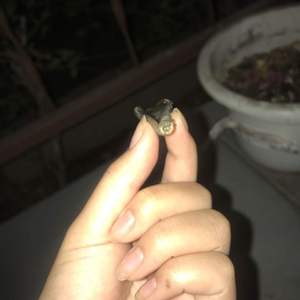


0
0
Khim_ali:@Liz Lynch okay I’ll give t a few more days , thank you!!
Liz Lynch:Give it a few more days.... but when you say soft - how soft? Softness usually means to much water 😊
Liz Lynch:I reckon this still may have potential to go



